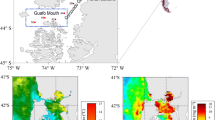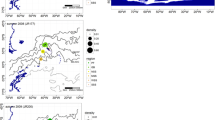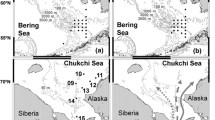Abstract
The great barracuda (Sphyraena barracuda) is a widespread, ecologically and socioeconomically important coastal fish, yet very little is known about its larvae. We examined spawning and larval ecology of Western Atlantic sphyraenids using monthly ichthyoplankton samples collected over 2 years along a transect spanning the east–west axis of the Straits of Florida (SOF). Samples were dominated by the great barracuda (92.8%) and sennets (Sphyraena borealis and Sphyraena picudilla; 6.6%). While larval sennets and S. barracuda displayed similar vertical distributions (majority in upper 25 m), horizontal and temporal patterns of abundance suggested a spatial and temporal species replacement between larval S. barracuda and sennets that tracks adult ecology. The diet of both taxa consisted largely of copepods, with inclusion of fish larvae at 8 mm SL, and in S. barracuda alone, a switch in the wet season to exclusive piscivory by 12 mm SL (18 days post-hatch). A lack of piscivory in S. barracuda larvae captured in the dry season corresponded to slower larval growth than in the wet season. Larval growth was also related to size-at-hatch and larval age such that larvae that were larger at hatch or larger (older) at capture grew faster at earlier ages, suggesting faster larval growth, and indirectly larger hatch size, conveys a survival advantage. Unlike larval growth, instantaneous mortality rate did not differ with season, and no lunar cyclic patterns in spawning output were identified. Our results provide insight into the pelagic phase of sphyraenids and highlight the importance of both diet and hatch size to the growth and survival of fish larvae in low latitude oceanic environments.








Similar content being viewed by others
References
Able KW, Fahay MP (1998) The first year in the life of estuarine fishes in the Middle Atlantic Bight. Rutgers Univeristy Press, New Brunswick
Anderson JT (1988) A review of size dependent survival during pre-recruit stages of fishes in relation to recruitment. J NW Atl Fish Sci 8:55–66
Ault JS, Bohnsack JA, Meester GA (1998) A retrospective (1979–1996) multispecies assessment of coral reef fish stocks in the Florida Keys. Fish Bull 96:395–414
Blaber SJM (1982) The ecology of Sphyraena barracuda (Osteichthyes: Perciformes) in the Kosi system with notes on the Sphyraenidae of other natal estuaries. S African J Zool 17:171–176
Cha SS, McGowan MF, Richards WJ (1994) Vertical distribution of fish larvae off the Florida Keys, 26 May-5 June 1989. Bull Mar Sci 54:828–842
Chambers RC (1997) Environmental influences on egg and propagule sizes in marine fishes. In: Chambers RC, Trippel EA (eds) Early life history and recruitment in fish populations. Chapman & Hall, London, pp 63–102
Comyns BH, Shaw RF, Lyczkowski-Shultz J (2003) Small-scale spatial and temporal variability in growth and mortality of fish larvae in the subtropical northcentral Gulf of Mexico: implications for assessing recruitment success. Fish Bull 101:10–21
Cowen RK, Sponaugle S (2009) Larval dispersal and marine population connectivity. Annu Rev Mar Sci 1:443–466
D’Alessandro E, Sponaugle S, Lee T (2007) Patterns and processes of larval fish supply to the coral reefs of the upper Florida Keys. Mar Ecol Prog Ser 331:85–100
D’Alessandro EK, Sponaugle S, Serafy JE (2010) Larval ecology of a suite of snappers (Family: Lutjanidae) in the Straits of Florida, western Atlantic Ocean. Mar Ecol Prog Ser 410:159–175
de Sylva DP (1963) Systematics and life history of the great barracuda, Sphyraena barracuda (Walbaum). Stud in Trop Oceanogr 1:1–179
Ditty JG, Shaw RF, Farooqi TW (2006) Sphyraenidae: barracudas. In: Richards WJ (ed) Early stages of Atlantic fishes: an identification guide for the western central north Atlantic. Taylor and Francis, New York, pp 2135–2147
Fisher R, Leis JM, Clark DL, Wilson SK (2005) Critical swimming speeds of late-stage coral reef fish larvae: variation within species, among species and between locations. Mar Biol 147:1201–1212
Gagliano M, McCormick MI (2007) Maternal condition influences phenotypic selection on offspring. J Anim Ecol 76:174–182
Gagliano M, McCormick MI, Meekan MG (2007) Survival against the odds: ontogenetic changes in selective pressure mediate growth-mortality trade-offs in a marine fish. Proc Royal Soc B 274:1575–1582
Govoni JJ, Laban EH, Hare JA (2003) The early life history of swordfish (Xiphias gladius) in the western North Atlantic. Fish Bull 101:778–789
Guigand CM, Cowen RK, Llopiz JK, Richardson DE (2005) A coupled asymmetrical multiple opening closing net with environmental sampling system. Mar Tech Soc J 39:22–24
Hare JA, Cowen RK (1995) Effect of age, growth rate and ontogeny on the relationship between otolith and somatic size in bluefish, Pomatomus saltatrix, and the implications for the back-calculation of size in the early life history stages of fishes. Can J Fish Aquat Sci 52:1909–1922
Hare JA, Cowen RK (1997) Size, growth, development, and survival of the planktonic larvae of Pomatomus saltatrix (Pisces: Pomatomidae). Ecology 78:2415–2431
Houde ED (1972) Development and early life history of the northern sennet, Sphyraena borealis DeKay (Pisces: Sphyraenidae) reared in the laboratory. Fishery Bulletin Natl Oceanic Atmos Adm 70:185–195
Houde ED (1987) Fish early life dynamics and recruitment variability. Amer Fish Soc Sym 2:17–29
Houde ED (1989) Comparative growth, mortality, and energetics of marine fish larvae: temperature and implied latitudinal effects. Fish Bull 87:471–495
Houde ED, Leak JC, Dowd CE, Berkeley SA, Richards WJ (1979) Ichthyoplankton abundance and diversity in the eastern Gulf of Mexico. Report for the US Department of the Interior, Bureau of Land Managment Gulf of Mexico OCS Office, New Orleans NTIS No PB299-839/AS
Irisson J, Paris CB, Guigand C, Planes S (2010) Vertical distribution and ontogenetic “migration” in coral reef fish larvae. Limnol Oceanogr 55:909–919
Johannes RE (1978) Reproductive strategies of coastal marine fishes in the tropics. Environ Biol Fish 3:65–84
Kadison E, D’Alessandro EK, Davis GO, Hood PB (2010) Age, growth, and reproductive patterns of the great barracuda, Sphyraena barracuda, from waters of the Florida Keys. Bull Mar Sci 86:773–784
Kimura DK (1980) Likelihood methods for the von Bertalanffy growth curve. Fish Bull 77:765–766
Leis JM (1991) The pelagic stage of reef fishes: the larval biology of coral reef fishes. In: Sale PF (ed) The ecology of fishes on coral reefs. Academic Press, New York, pp 183–230
Llopiz JK (2008) The trophic ecologies of larval billfishes, tunas and coral reef fishes in the Straits of Florida: piscivory, selectivity, and niche separation. Marine Biology and Fisheries, Coral Gables
Llopiz JK, Cowen RK (2008) Precocious, selective and successful feeding of larval billfishes in the oceanic Straits of Florida. Mar Ecol Prog Ser 358:231–244
Llopiz JK, Cowen RK (2009) Variability in the trophic role of coral reef fish larvae in the oceanic plankton. Mar Ecol Prog Ser 381:259–272
Llopiz JK, Richardson DE, Shiroza A, Smith SL, Cowen RK (2010) Distinctions in the diets and distributions of larval tunas and the important role of appendicularians. Limnol Oceanogr 55:983–996
Longhurst AR, Pauly D (1987) Ecology of tropical oceans. Academic Press, San Diego, CA
Marteinsdottir G, Steinarsson A (1998) Maternal influence on the size and viability of Iceland cod Gadus morhua eggs and larvae. J Fish Biol 52:1241–1258
McCormick MI (1999) Experimental test of the effect of maternal hormones on larval quality of a coral reef fish. Oecologia 118:412–422
McCormick MI, Hoey AS (2004) Larval growth history determines juvenile growth and survival in a tropical marine fish. Oikos 106:225–242
Meekan MG, Fortier L (1996) Selection for fast growth during the larval life of Atlantic cod Gadus morhua on the Scotian Shelf. Mar Ecol Prog Ser 137:25–37
Meekan MG, Carleton JH, McKinnon AD, Flynn K, Furnas M (2003) What determines the growth of tropical reef fish larvae in the plankton: food or temperature? Mar Ecol Prog Ser 256:193–204
Meekan MG, Vigliola L, Hansen A, Doherty PJ, Halford A, Carleton JH (2006) Bigger is better: size-selective mortality throughout the life history of a fast-growing clupeid, Spratelloides gracilis. Mar Ecol Prog Ser 317:237–244
Mendiola D, Ibaibarriaga L, Alvarez P (2007) Thermal effects on growth and time to starvation during the yolk-sac larval period of Atlantic mackerel Scomber scombrus. J Fish Biol 70:895–910
Morse WW (1989) Catchability, growth, and mortality of larval fishes. Fish Bull 87:417–446
Nelson JS (2006) Fishes of the World. John Wiley & Sons, Inc., New York
Nielsen R, Munk P (2004) Growth pattern and growth dependent mortality of larval and pelagic juvenile North Sea cod Gadus morhua. Mar Ecol Prog Ser 278:261–270
Olsen DA, Nellis DW, Wood RS (1984) Ciguatera in the eastern Caribbean. Mar Fish Rev 46:13–18
Richards WJ (2006) Early stages of Atlantic fishes: an identification guide for the Western central North Atlantic. Taylor and Francis, New York
Richardson DE, Cowen RK, Prince ED, Sponaugle S (2009) Importance of the Straits of Florida spawning ground to Atlantic sailfish (Istiophorus platypterus) and blue marlin (Makaira nigricans). Fish Oceanogr 18:402–418
Robertson DR (1991) The role of adult biology in the timing of spawning of tropical reef fishes. In: Sale PF (ed) The ecology of fishes on coral reefs. Academic Press, New York
Robertson DR, Petersen CW, Brawn JD (1990) Lunar reproductive cycles of benthic-brooding reef fishes: reflections of larval biology or adult biology? Ecol Monogr 60:311–329
Ropke A, Nellen W, Piatkowski U (1993) A comparative study on the influence of the pycnocline on the vertical distribution of fish larvae and cephalopod paralarvae in three ecologically different areas of the Arabian Sea. Deep Sea Res 40:801–819
Russell BC (2002) Sphyraenidae: barracudas. In: Carpenter KE (ed) The living marine resources of the Western Central Atlantic: bony fishes part 2 (Opistognathidae to Molidae) FAO species identification guide for fishery purposes and American society of ichthyologist and herpetologists special publication. Food and Agriculture Organization of the United Nations, Rome, pp 1807–1811
Sandknop EM, Watson W (1996) Sphyraenidae: barracudas. In: Moser HG (ed) The early stages of fishes in the California current region. Allen Press, Inc., Lawrence
Satoh K, Tanaka Y, Wahashi M (2008) Variations in the instantaneous mortality rate between larval patches of Pacific bluefin tuna Thunnus orientalis in the northwestern Pacific Ocean. Fish Res 89:248–256
Schmidt TW (1989) Food habits, length-weight relationship and condition factor of young great barracuda, Sphyraena barracuda (Walbaum), from Florida Bay, Everglades National Park, Florida. Bull Mar Sci 44:163–170
Searcy SP, Sponaugle S (2001) Selective mortality during the larval-juvenile transition in two coral reef fishes. Ecology 82:2452–2470
Serafy JE, Valle M, Faunce CH, Luo J (2007) Species-specific patterns of fish abundance and size along a subtropical mangrove shoreline: an application of the delta approach. Bull Mar Sci 80:609–623
Shoji J, Machara T, Tanaka M (2005) Larval growth and mortality of Japanese Spanish mackerel (Scomberomorus niphonius) in the central Seto Inland Sea, Japan. J Mar Biol Assoc UK 85:1255–1261
Sponaugle S, Grorud-Colvert K (2006) Environmental variability, early life-history traits, and survival of new coral reef fish recruits. Integr Comp Biol 46:623–633
Sponaugle S, Denit KL, Luthy SA, Serafy JE, Cowen RK (2005) Growth variation in larval Makaira nigricans. J Fish Biol 66:822–835
Sponaugle S, Grorud-Colvert K, Pinkard D (2006) Temperature-mediated variation in early life history traits and recruitment success of the coral reef fish Thalassoma bifasciatum in the Florida Keys. Mar Ecol Prog Ser 308:1–15
Sponaugle S, Llopiz JK, Havel LN, Rankin TL (2009) Spatial variation in larval growth and gut fullness in a coral reef fish. Mar Ecol Prog Ser 383:239–249
Sponaugle S, Walter KD, Denit KL, Llopiz JK, Cowen RK (2010) Variation in pelagic larval growth of Atlantic billfishes: the role of prey composition and selective mortality. Mar Biol 157:839–849
Tanaka M, Kaji T, Nakamura Y (1996) Developmental strategy of scombrid larvae: high growth potential related to food habits and precocious digestive system development. In: Watanabe Y, Yamashita Y, Oozeki Y (eds) Survival strategies in early life stages of marine resources. A. A. Balkema, Rotterdam, pp 125–139
Tanaka Y, Satoh K, Iwahashi M, Yamada H (2006) Growth-dependent recruitment of Pacific bluefin tuna Thunnus orientalis in the northwestern Pacific Ocean. Mar Ecol Prog Ser 319:225–235
Vigliola L, Meekan MG (2002) Size at hatching and planktonic growth determine post-settlement survivorship of a coral reef fish. Oecologia 131:89–93
Zar JH (1999) Biostatistical analysis, 4th edn. Prentice Hall, Upper Saddle River, NJ
Acknowledgments
This study was supported by a National Science Foundation grant (OCE 0136132) to R. K. Cowen, S. Sponaugle, S. Smith, K. Leaman, D. Olson, and J. Serafy, and a Don deSylva Memorial Award, International Light Tackle Tournament Association research grant, Harry D. Vernon Scholarship, and Circle of Friends Memorial Scholarship to E. K. D’Alessandro. D. Richardson, C. Guigand, P. Lane, A. Shiroza, K. Leaman, P. Vertes, K. Huebert, and S. Smith participated in shipboard cruises. All samples were collected under University of Miami Animal Care and Use Committee permit nos. 02063 and 05134. L. Gundlach, A. Exum, and S. Trbovich sorted samples, and D. Richardson assisted with family level identifications. Assistance with morphological identification was provided by C. Paris-Limouzy, and assistance with molecular identification of larvae was provided by D. Crawford and A. Esbaugh. C. Gioia helped with otolith dissection, and M. Schmale provided the fluorescent transmission light microscope for use in daily increment validation. Valuable and thoughtful comments from J. Serafy, D. Lirman, A. Acosta, M. Peck, and two anonymous reviewers improved an earlier version of this manuscript.
Author information
Authors and Affiliations
Corresponding author
Additional information
Communicated by M. A. Peck.
Rights and permissions
About this article
Cite this article
D’Alessandro, E.K., Sponaugle, S., Llopiz, J.K. et al. Larval ecology of the great barracuda, Sphyraena barracuda, and other sphyraenids in the Straits of Florida. Mar Biol 158, 2625–2638 (2011). https://doi.org/10.1007/s00227-011-1771-y
Received:
Accepted:
Published:
Issue Date:
DOI: https://doi.org/10.1007/s00227-011-1771-y




